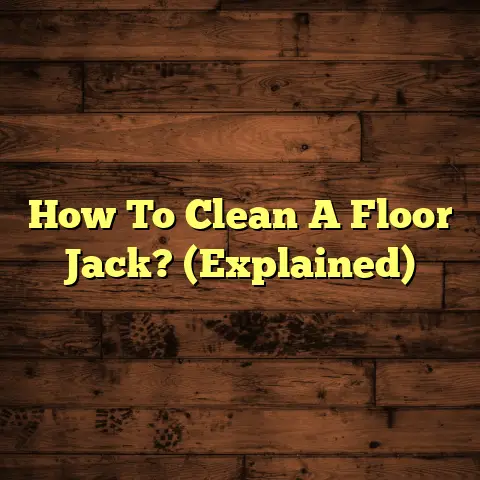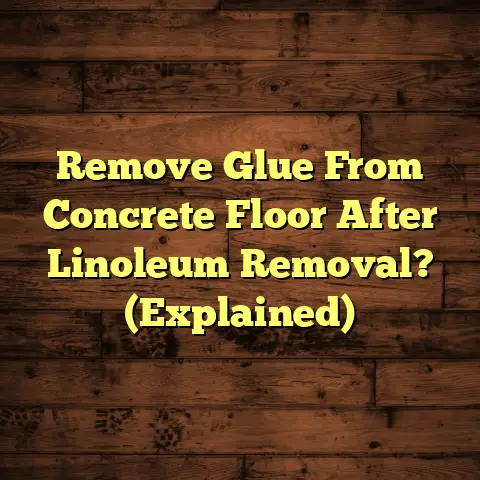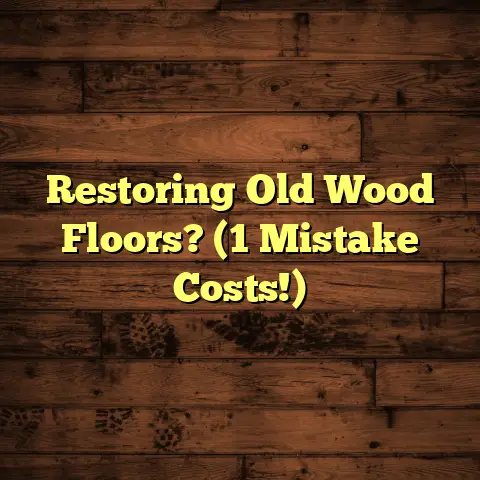What Should I Use To Paint My Garage Floor?
Section 1: Understanding Garage Flooring Options
1.1 Types of Garage Floors
Most garages have concrete floors, which are durable but porous. This means they’re susceptible to stains, cracks, and moisture damage. Other, less common options include:
-
Epoxy-coated floors: These are highly durable and resistant to chemicals, but they can be expensive and require professional installation.
-
Rubber tiles: These are comfortable underfoot and offer good impact resistance, ideal for a home gym.
-
Sealed concrete: A basic sealant can protect against some stains and moisture, but it’s not as durable as paint or epoxy.
1.2 Benefits of Painting Your Garage Floor
Why bother painting your garage floor? Here are a few compelling reasons:
- Aesthetics: A painted floor looks clean and inviting, instantly improving the appearance of your garage.
- Protection: Paint acts as a barrier against oil, chemicals, and other spills that can damage the concrete.
- Durability: A good paint job can extend the life of your garage floor by protecting it from wear and tear.
- Safety: Painted floors are easier to clean and can be less slippery than bare concrete, especially when wet.
- Value: A well-maintained garage adds value to your home.
1.3 Common Problems with Unfinished or Poorly Maintained Floors
I can’t tell you how many times I’ve seen these issues:
- Staining: Oil, grease, and other fluids can penetrate the concrete, leaving unsightly stains.
- Cracking: Temperature changes and heavy loads can cause cracks to form in the concrete.
- Dusting: Concrete can break down over time, creating a fine dust that coats everything in your garage.
- Moisture damage: Water can seep into the concrete, leading to mold growth and further deterioration.
- Slipping hazards: Bare concrete can become slippery, especially when wet or oily.
Section 2: Preparing Your Garage Floor for Painting
Preparation is KEY. Skimp on this, and you’ll regret it.
2.1 Cleaning the Floor: Tools and Techniques
This is the most important step! A clean surface is crucial for proper paint adhesion. Here’s what I recommend:
- Sweep: Start by sweeping the entire floor to remove loose debris. I like using a stiff-bristled broom for this.
- Scrub: Use a concrete cleaner and a scrub brush to remove dirt, oil, and grease. For tough stains, you might need a degreaser. I often use a pressure washer with a wide-angle nozzle for this step, but be careful not to damage the concrete.
- Rinse: Rinse the floor thoroughly with clean water to remove all traces of the cleaner.
- Etch: Etching the concrete opens up the pores,
allowing the paint to bond better. You can use
muriatic acid or a commercial etching product.
- Safety First: Always wear gloves, eye protection, and a respirator when working with muriatic acid. Follow the manufacturer’s instructions carefully.
- Neutralize: After etching, neutralize the acid with a solution of baking soda and water.
- Rinse Again: Rinse the floor thoroughly with clean water and let it dry completely.
2.2 Repairing Cracks and Imperfections
Cracks and holes will show through the paint, so it’s important to fix them first.
- Clean: Use a wire brush to remove loose debris from the cracks.
- Fill: Fill the cracks with a concrete crack filler or epoxy patching compound. Follow the manufacturer’s instructions for application and drying time.
- Sand: Once the filler is dry, sand it smooth to blend it with the surrounding concrete.
2.3 Choosing the Right Time of Year for Painting
Temperature and humidity can affect the paint’s drying time and adhesion. I generally recommend:
- Temperature: Aim for temperatures between 60°F and 80°F (15°C and 27°C).
- Humidity: Avoid painting on days with high humidity, as this can slow down the drying process.
- Dry Weather: Make sure the floor is completely dry before you start painting.
Pro Tip: Check the weather forecast before you start painting. You want to avoid rain or extreme temperatures for at least 24 hours after you finish.
Section 3: Selecting the Right Paint for Your Garage Floor
This is where things get interesting. There are several types of paint to choose from, each with its own pros and cons.
3.1 Types of Paint: Epoxy, Latex, and Other Options
- Epoxy Paint: This is the most durable and
popular option for garage floors. It’s resistant to
chemicals, abrasion, and impact. Epoxy paint
typically comes in two parts that you mix together
before applying.
- 100% Solids Epoxy: I prefer this, it’s expensive but more durable.
- Latex Acrylic Paint: This is a more affordable option, but it’s not as durable as epoxy. It’s easier to apply and clean up, but it’s more susceptible to stains and wear. Look for a latex paint specifically designed for concrete floors.
- Urethane Paint: This is another durable option that’s resistant to chemicals and abrasion. It’s more expensive than latex paint but less expensive than epoxy.
- Concrete Stain: If you want to add color to your garage floor without completely covering the concrete, a concrete stain is a good option. It penetrates the concrete and provides a translucent finish.
3.2 Pros and Cons of Each Type of Paint
Here’s a quick breakdown:
| Paint Type | Pros | Cons |
|---|---|---|
| Epoxy | Highly durable, chemical resistant, abrasion resistant, long-lasting, professional look | More expensive, requires careful preparation and application, longer drying time, can be slippery if not properly textured |
| Latex Acrylic | Affordable, easy to apply, easy to clean up, water-based | Less durable than epoxy, more susceptible to stains and wear, shorter lifespan, may require more frequent repainting |
| Urethane | Durable, chemical resistant, abrasion resistant, good balance of cost and performance | More expensive than latex, requires careful preparation and application, can be difficult to find in some areas |
| Concrete Stain | Adds color without completely covering the concrete, penetrates the concrete for a natural look, resists fading | Doesn’t provide as much protection as paint, may require a sealer, limited color options |
3.3 Color and Finish Options: What Works Best?
- Color: Light colors can make your garage look brighter and more spacious. Dark colors can hide dirt and stains better. I often recommend a medium gray, as it strikes a good balance.
- Finish: Glossy finishes are easier to clean but can be slippery. Matte finishes provide better traction but can be more difficult to clean. You can also add a non-slip additive to your paint to improve traction.
- Popular Choices:
- Light Gray: Reflects light, hides minor imperfections.
- Dark Gray: Hides dirt and stains well.
- Beige/Tan: Warm and inviting.
- Blue/Green: Adds a pop of color, can make the space feel larger.
Personal Story: I once had a client who insisted on a bright red garage floor. While it looked striking at first, it quickly showed every speck of dirt and dust. We ended up repainting it a more practical gray!
Section 4: Essential Tools and Materials for Painting
Having the right tools makes all the difference.
4.1 Brushes, Rollers, and Sprayers: Which to Use?
- Brushes: Use a high-quality brush for cutting in around the edges and corners. I prefer a 2-inch angled brush for this.
- Rollers: Use a roller with a nap length recommended by the paint manufacturer. A 3/8-inch nap is usually a good choice for smooth concrete floors.
- Sprayers: A paint sprayer can be used to apply the paint quickly and evenly, but it requires more skill and preparation. You’ll need to mask off the walls and other surfaces to protect them from overspray. I generally only recommend sprayers for large, open garages.
4.2 Safety Gear: Importance of Protection
- Respirator: Protect your lungs from paint fumes.
- Gloves: Protect your skin from paint and chemicals.
- Eye Protection: Protect your eyes from splashes.
- Old Clothes: Wear clothes you don’t mind getting dirty.
- Ventilation: Open the garage door and windows to provide adequate ventilation.
4.3 Additional Materials: Primer, Sealers, and Additives
- Primer: A primer can improve paint adhesion and provide a more uniform finish. Use a primer specifically designed for concrete floors.
- Sealer: A sealer can protect the paint from stains and wear. Apply a sealer after the paint has dried completely.
- Non-Slip Additive: Add a non-slip additive to the paint to improve traction, especially if you’re using a glossy finish.
- Paint Thinner: Use paint thinner to clean your brushes and rollers.
- Mixing Sticks: Use mixing sticks to stir the paint thoroughly.
- Painter’s Tape: Use painter’s tape to mask off the walls and other surfaces.
- Drop Cloths: Use drop cloths to protect the floor from paint spills.
Section 5: Step-by-Step Guide to Painting Your Garage Floor
Let’s get down to business!
5.1 Detailed Preparation Steps
- Clear the Garage: Remove everything from the garage.
- Clean the Floor: Follow the cleaning steps outlined in Section 2.1.
- Repair Cracks: Fill any cracks or holes in the concrete.
- Etch the Concrete: Etch the concrete to improve paint adhesion.
- Apply Primer: Apply a coat of concrete primer. Let it dry completely according to the manufacturer’s instructions.
- Mask Off Areas: Use painter’s tape to mask off the walls and other surfaces.
5.2 The Painting Process: Techniques and Tips
- Mix the Paint: Mix the paint thoroughly according to the manufacturer’s instructions. If you’re using a two-part epoxy, mix the two parts together carefully.
- Cut In: Use a brush to cut in around the edges and corners.
- Roll the Paint: Use a roller to apply the paint to the rest of the floor. Apply the paint in thin, even coats.
- Apply a Second Coat: Let the first coat dry completely according to the manufacturer’s instructions. Then, apply a second coat of paint.
- Remove Tape: Carefully remove the painter’s tape while the paint is still slightly wet.
5.3 Curing and Drying Times: What to Expect
- Drying Time: The drying time will vary depending on the type of paint you use and the temperature and humidity. Generally, latex paint will dry faster than epoxy paint.
- Curing Time: The curing time is the amount of time it takes for the paint to fully harden and reach its maximum durability. This can take several days.
- Avoid Traffic: Avoid walking or driving on the painted floor until it has fully cured.
Real-World Example: I painted my own garage floor with epoxy paint last summer. It took about 24 hours for the paint to dry to the touch, but I waited a full week before parking my car in the garage to ensure it was fully cured.
Section 6: Maintenance Tips for Your Painted Garage Floor
A little maintenance goes a long way.
6.1 Cleaning and Upkeep
- Sweep Regularly: Sweep the floor regularly to remove dirt and debris.
- Mop as Needed: Mop the floor with a mild detergent and water as needed.
- Clean Spills Immediately: Clean up spills immediately to prevent staining.
- Use Floor Mats: Use floor mats under cars and equipment to protect the paint from wear.
6.2 How to Handle Damage or Wear
- Touch Up Scratches: Touch up scratches with a small amount of paint.
- Repair Chips: Repair chips with a concrete patching compound.
- Re-Coat Worn Areas: Re-coat worn areas with a fresh coat of paint.
6.3 When to Repaint
- Visible Wear: When the paint starts to show significant wear and tear, it’s time to repaint.
- Staining: If the floor is heavily stained, it’s time to repaint.
- Peeling: If the paint is peeling, it’s time to repaint.
- General Rule: Depending on the type of paint you use and the amount of traffic in your garage, you may need to repaint every 3-5 years.
Section 7: Conclusion: Investing in Your Garage Space
So, what should you use to paint your garage floor? It depends on your budget, your needs, and your DIY skills. Epoxy paint is the most durable and long-lasting option, but it’s also the most expensive and requires careful preparation and application. Latex acrylic paint is a more affordable option, but it’s not as durable.
No matter which type of paint you choose, remember that proper preparation is key to a successful paint job. Take the time to clean and repair the floor before you start painting, and follow the manufacturer’s instructions carefully.
Investing in your garage space is an investment in your home. A well-maintained garage floor can improve the appearance of your garage, protect the concrete from damage, and increase the value of your home. So, go ahead and give your garage floor the makeover it deserves!
I hope this guide has been helpful. If you have any questions, feel free to ask! Good luck with your garage floor painting project!





